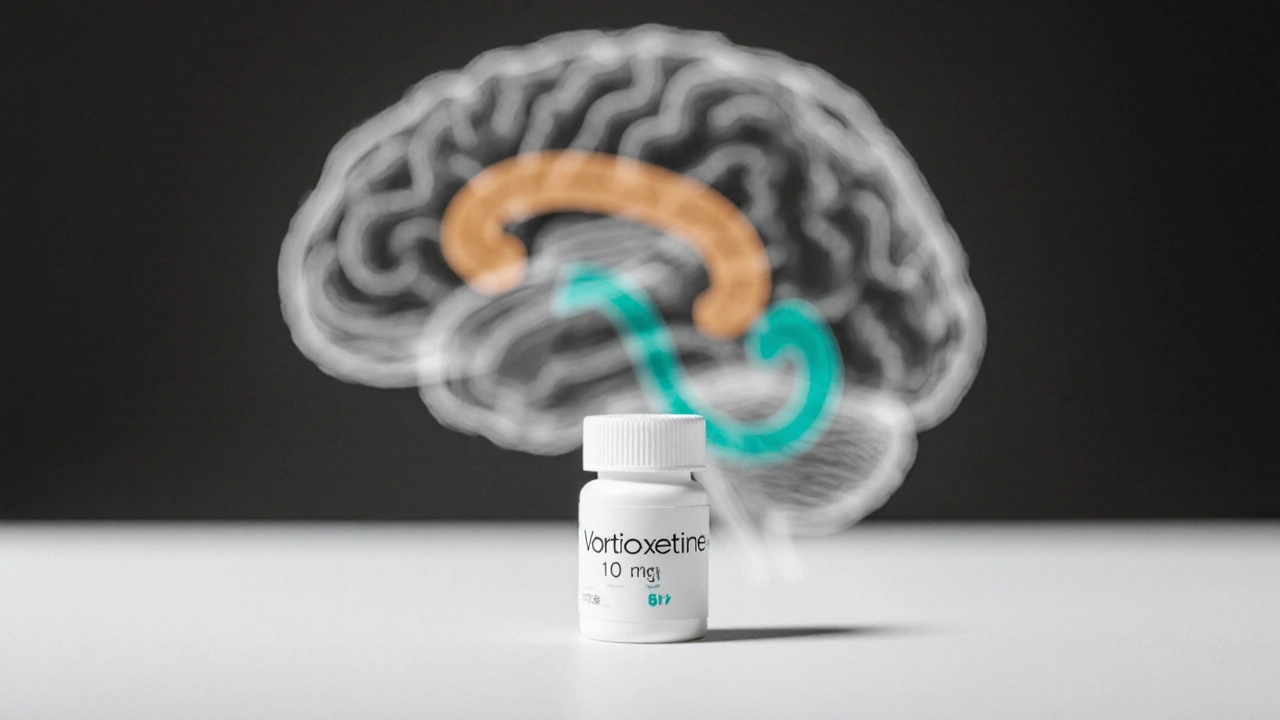SAD Treatment Decision Tool
Which treatment might work best for you?
This tool helps you evaluate treatment options for Seasonal Affective Disorder based on your symptoms, preferences, and medical history. Results are based on clinical data from the article on vortioxetine for SAD.
Tell us about your situation
1. What are your primary concerns?
2. Which treatments have you tried already?
3. Are you on any medications that might interact with vortioxetine?
Your Treatment Recommendation
When daylight drops, many people notice a dip in mood. Vortioxetine is a multimodal antidepressant that modulates serotonin receptors and the transporter and has been approved for major depressive disorder. But can the same pill lift the winter blues that define Seasonal Affective Disorder (SAD)? This article breaks down the science, the clinical data, and the practical factors you need to decide if vortioxetine is worth a try.
What is Seasonal Affective Disorder?
Seasonal Affective Disorder is a mood‑changing pattern that typically recurs each year during the shorter days of autumn and winter. Its hallmark symptoms include low energy, oversleeping, carbohydrate cravings, and a pervasive sense of sadness that eases when spring returns. Epidemiology studies suggest that 1‑10% of adults in northern latitudes experience clinically significant SAD, with higher rates in places like Canada where winter daylight can be under 8hours.
Vortioxetine: How It Works
Vortioxetine belongs to a newer class of antidepressants that act as a serotonin‑modulating agent. It blocks the serotonin transporter (SERT) while simultaneously stimulating several serotonin receptors (5‑HT1A) and blocking others (5‑HT3, 5‑HT7). This multitarget approach is thought to improve mood, cognition, and anxiety more comprehensively than traditional selective serotonin reuptake inhibitors (SSRIs).
The U.S. Food and Drug Administration (FDA) approved vortioxetine in 2013 for major depressive disorder in adults. In Canada, Health Canada granted the same indication in 2015. The typical starting dose is 10mg once daily, titrated up to 20mg based on response and tolerability.
Why Consider Vortioxetine for SAD?
The logic is simple: if vortioxetine can lift mood in major depression, perhaps it can also help the milder, seasonal form. However, official guidelines still list light therapy, psychotherapy, and bupropion as first‑line options for SAD because those treatments have robust, season‑specific data.
Published studies on vortioxetine and SAD are few but informative. A 2022 open‑label trial in a northern‑US clinic enrolled 56 patients with DSM‑5-confirmed SAD. Participants received vortioxetine 10mg daily for eight weeks. At week8, 64% reported a ≥50% reduction in the Hamilton Depression Rating Scale (HDRS) scores, comparable to response rates seen with standard light therapy.
Another real‑world analysis from a Canadian tertiary center (2023) reviewed electronic health records of 112 patients prescribed vortioxetine during the fall months. The authors noted that 58% achieved remission (HDRS ≤7) by the end of winter, and side‑effects were generally mild (nausea, transient headache). While promising, these studies are not randomized controlled trials, so the evidence remains “suggestive, not definitive.”

How Vortioxetine Stacks Up Against Other SAD Treatments
| Intervention | Effectiveness (HDRS reduction) | Onset of Relief | Typical Side Effects | Best For |
|---|---|---|---|---|
| Bright Light Therapy (10,000lux) | ≈55‑70% responders | 3‑7days | Headache, eye strain | Patients preferring non‑pharmacologic option |
| Bupropion XL (150‑300mg) | ≈60‑75% responders | 1‑2weeks | Insomnia, dry mouth | Those needing an energizing effect |
| Selective Serotonin Reuptake Inhibitor (e.g., sertraline) | ≈45‑60% responders | 2‑4weeks | Nausea, sexual dysfunction | Patients already on an SSRI |
| Vortioxetine | ≈60‑65% responders (open‑label) | 1‑3weeks | Nausea, dizziness (usually mild) | Individuals who need both mood lift and cognitive benefits |
The table shows that vortioxetine’s response rates are on par with the pharmacologic gold standard (bupropion) and better than many SSRIs for SAD‑type symptoms. Its onset appears slightly faster than typical SSRIs, which could matter when winter is fast‑approaching.
Practical Considerations Before Starting Vortioxetine
- Dosage: Begin with 10mg once daily. If tolerated, increase to 20mg after two weeks for greater symptom control.
- Side‑effects: The most common is mild nausea, which usually fades within a week. Rarely, patients experience dizziness or sexual dysfunction.
- Drug Interactions: Vortioxetine is metabolized by CYP2D6. Avoid concurrent strong CYP2D6 inhibitors (e.g., fluoxetine, paroxetine) unless dose adjustments are made.
- Monitoring: Baseline HDRS or PHQ‑9 scores help track improvement. Re‑evaluate after 4‑6 weeks of steady dosing.
- Special Populations: In older adults, start at 5mg daily to reduce nausea risk. Pregnancy safety data are limited, so discuss alternatives with a clinician.

When Vortioxetine Might Be the Right Choice
Consider vortioxetine if:
- You have tried light therapy or bupropion with limited benefit.
- You experience cognitive fog (poor concentration, slow thinking) alongside mood lows-vortioxetine has shown modest cognitive enhancement in trials.
- You already take an SSRI but cannot tolerate its sexual side‑effects; switching to vortioxetine may improve tolerability.
Conversely, if you prefer a medication‑free approach, have a history of severe nausea, or are on multiple CYP2D6 inhibitors, traditional light therapy or bupropion may be safer first steps.
Key Takeaways
- Vortioxetine is a serotonin‑modulating antidepressant approved for major depression, not specifically for SAD.
- Limited open‑label and real‑world data suggest response rates comparable to established SAD treatments.
- Its side‑effect profile is generally mild, with nausea being the most common.
- Best suited for patients who need both mood improvement and cognitive clarity, especially after other options fall short.
- Always discuss with a healthcare provider to weigh benefits, drug interactions, and personal preferences before starting.
Frequently Asked Questions
Is vortioxetine officially approved for treating SAD?
No. Vortioxetine is approved for major depressive disorder. Its use for Seasonal Affective Disorder is off‑label and based on emerging clinical observations.
How quickly can I expect mood improvement with vortioxetine?
Most patients notice a reduction in depressive symptoms within 1‑3weeks, though full therapeutic effect may take up to 4‑6weeks.
Can I combine vortioxetine with bright‑light therapy?
Yes. Combining a pharmacologic agent with light therapy is common practice and can provide additive benefits. Consult your prescriber for timing and dosage coordination.
What are the most common side effects I should watch for?
Mild nausea, occasional dizziness, and transient headache are the most frequently reported. These usually resolve within the first week of treatment.
Is vortioxetine safe for older adults?
Older patients can use vortioxetine, but a lower starting dose (5mg) is advisable to minimize nausea. Regular monitoring of mood and cognitive function is recommended.
How does vortioxetine differ from traditional SSRIs?
Beyond blocking the serotonin transporter, vortioxetine also modulates several serotonin receptors, which may lead to improved cognitive function and a slightly different side‑effect profile compared with standard SSRIs.
Should I stop my current antidepressant before starting vortioxetine?
Transitioning should be done under medical supervision. A gradual taper of the existing drug while initiating vortioxetine helps avoid withdrawal or serotonin syndrome.


Kripa Mohamed
October 15, 2025
I bet pharma bigwigs are just pushing vortioxetine to keep us dependent.
Crystal Doofenschmirtz
October 18, 2025
The article does a good job summarizing the current evidence, and it’s clear that vortioxetine isn’t yet a first‑line SAD treatment. Light therapy still has the strongest data, but having an off‑label medication option can be useful for people who don’t respond well. The side‑effect profile looks mild, which is reassuring for many patients. It’s always smart to discuss these options with a clinician before making a decision.
Pankaj Kumar
October 21, 2025
Hey folks, if you’ve been wrestling with the winter blues and typical meds haven’t hit the mark, vortioxetine might be worth a shot. Its multimodal action can lift mood while also sharpening that foggy brain, which feels like a double win. Start low, watch how you feel, and remember you can always pair it with bright‑light sessions for extra boost. Many people report smoother evenings and better focus once the nausea settles. Keep an eye on how you respond and stay in touch with your prescriber.
Mauricio Banvard
October 24, 2025
Sure, vortioxetine sounds fancy, but the open‑label studies are basically glorified anecdotes. I’m not buying the hype until we get a solid double‑blind trial that isn’t funded by the drug company. Plus, the industry loves to push meds that keep us buying forever.
Paul Hughes
October 27, 2025
Winter can feel endless, but remember you’re not alone in this slump. If you give vortioxetine a try, keep tracking your mood and celebrate the small wins 😊. Even a modest lift can make the season feel a lot brighter.
Mary Latham
October 30, 2025
Actually the open‑label data is more promising than you think, tehy show a 64% response rate. But yeah, it’s always good to stay critical, definately.
Marie Green
November 2, 2025
That sounds helpful and realistic keep it simple and listen to your body
TOM PAUL
November 4, 2025
From a cultural perspective, many northern communities already rely on light boxes and community gatherings to fight SAD. Adding a medication like vortioxetine can complement those traditions, especially for those who need extra cognitive clarity. It’s fascinating how pharmacology and lifestyle interventions can dance together. If you’re considering it, think about how it fits with your daily routines and support networks.
Ash Charles
November 7, 2025
Don’t overthink it – just start the dose and monitor, you’ll see results faster than you expect.
Adam Khan
November 10, 2025
While the article is generally well‑structured, there are several grammatical inconsistencies that merit correction. Firstly, the phrase “are under 8hours” should be rendered as “are under 8 hours” with a space. Secondly, “the authors noted that 58% achieved remission (HDRS ≤7) by the end of winter” could be clarified by inserting a comma after “remission”. Lastly, the use of “off‑label” is correct but could be hyphenated consistently throughout the text. Overall, the technical terminology is appropriate, yet precision in syntax enhances credibility.
rishabh ostwal
November 13, 2025
It is disconcerting that even meticulous editors overlook the broader ethical implications of promoting a drug without robust randomized evidence. One must question whether the pharmaceutical agenda overshadows patient welfare. Therefore, we should demand higher standards before endorsing vortioxetine for seasonal afflictions.
Kristen Woods
November 16, 2025
Oh dear, the very mention of vortioxetine sends tremors through my scholarly heart! Do we truly believe that a single pill can chase away the bleak, icy fingers of winter? The authors parade a handful of open‑label trials as if they were gospel, but those numbers are as fragile as frost on a windowpane. Imagine the poor souls, half‑asleep, reaching for a bottle of pills while the world outside is draped in perpetual dusk. Their side‑effects, mild as they claim-nausea, dizziness-are but whispers compared to the roaring storm of uncertainty that follows off‑label use. And yet, the tables turn when one reads that 64% of participants reported a fifty‑percent drop in HDRS, a statistic that dazzles like a sudden sunrise. But is it not the classic tale of hope sold in a capsule, whispering promises of cognitive clarity while the mind remains fogbound? The comparative table, though elegant, hides the fact that light therapy cures without a prescription, free from the shackles of pharma profit. Bupropion, that old warrior, still stands tall, yet vortioxetine is painted as the new hero without the battles to prove it. I cannot help but feel that the publication, perhaps unintentionally, fuels a market‑driven narrative rather than a purely scientific discourse. Still, for those whose winter gloom refuses to lift, any weapon-be it light, therapy, or medication-might be a lifeline. Thus, while I remain skeptical, I also understand the desperation that drives patients to clutch at any potential relief. Caution, dear readers, must accompany enthusiasm; the shadows of side‑effects loom, however faint. Consult your physician, weigh the modest benefits against the unknown, and remember that no singular solution fits all winter souls. In the end, perhaps the true antidote lies not solely in a pill but in a tapestry of light, support, and resilient spirit.
Carlos A Colón
November 19, 2025
Sure, because reading fifteen dramatic sentences is exactly what we need before deciding on a medication.
Aurora Morealis
November 22, 2025
Just a note: “vortioxetine” should be capitalized at the start of a sentence and “HDRS” is an abbreviation that benefits from a hyphen when used adjectivally (e.g., “HDRS‑based”). Otherwise great.